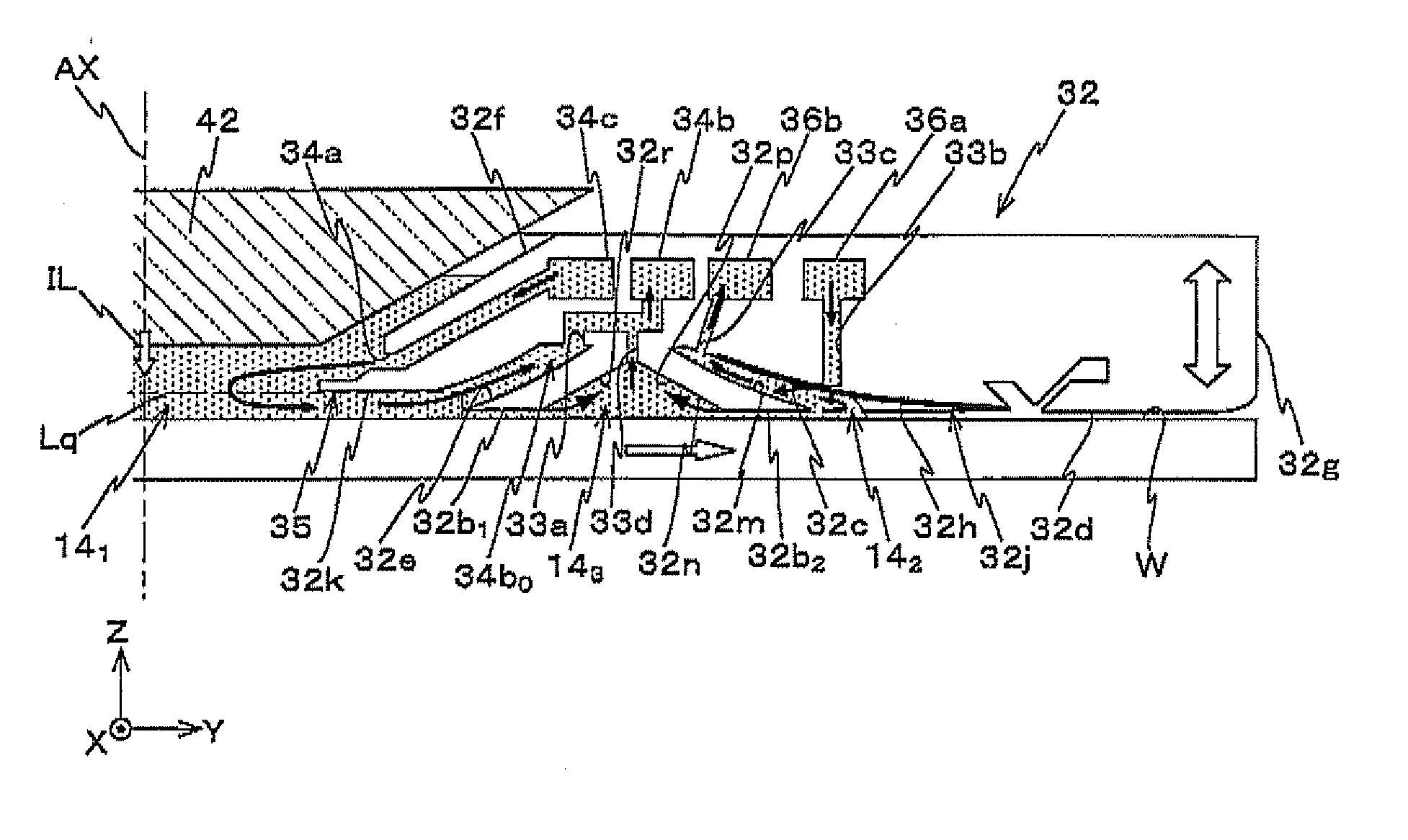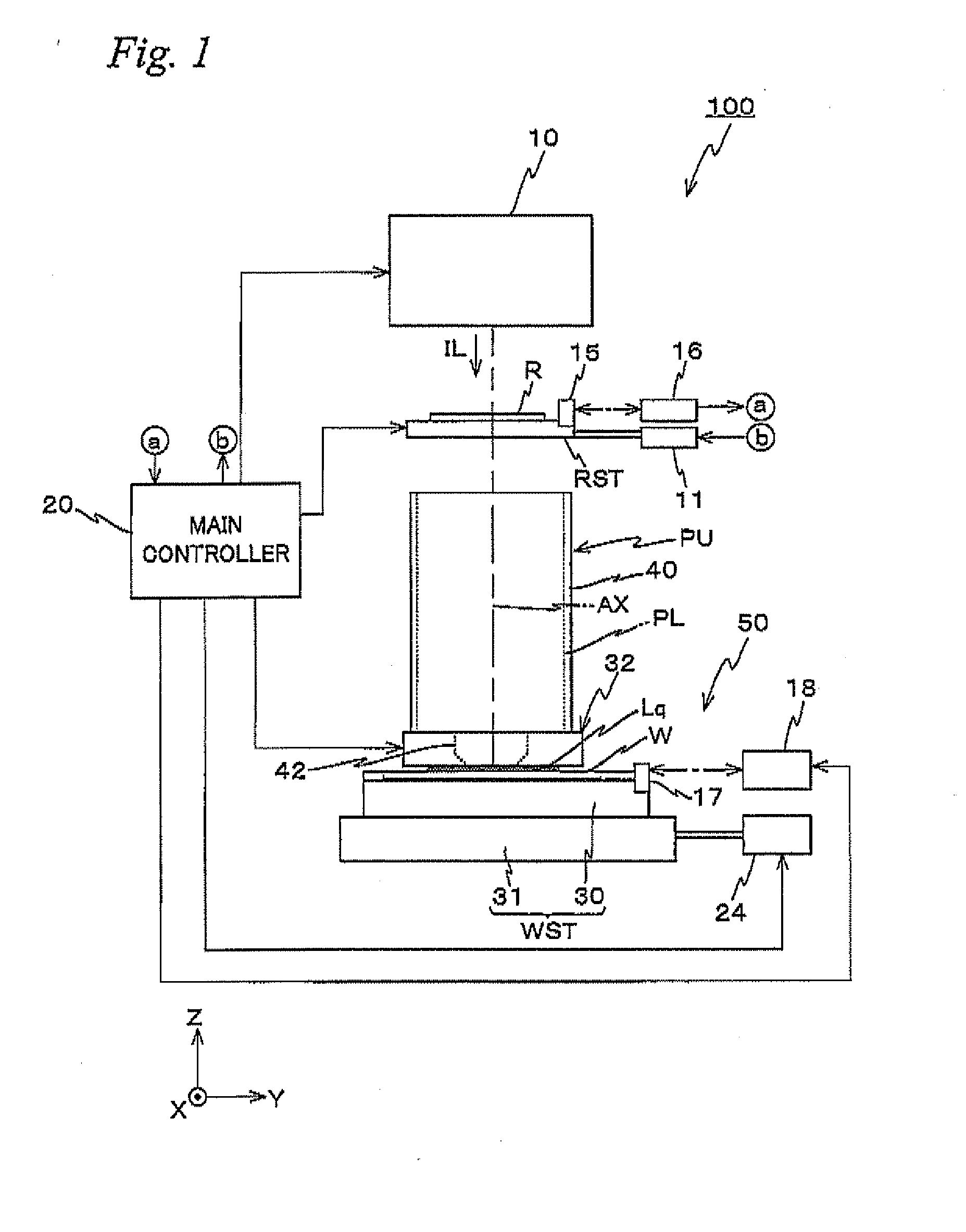Exposure apparatus, liquid immersion member, and device manufacturing method
a technology of liquid immersion and equipment, applied in the direction of photomechanical treatment, printing, instruments, etc., can solve the problems of reducing throughput, increasing cost, and defecting the pattern formed on the wafer
- Summary
- Abstract
- Description
- Claims
- Application Information
AI Technical Summary
Benefits of technology
Problems solved by technology
Method used
Image
Examples
first embodiment
[0041]Hereinafter, a first embodiment of the present invention will be described, with reference to FIGS. 1 to 13.
[0042]FIG. 1 schematically shows the configuration of an exposure apparatus 100 related to the present embodiment. Exposure apparatus 100 is a projection exposure apparatus by the step-and-scan method (or a so-called scanning stepper). As it will be described later, a projection optical system PL is arranged in the embodiment, and in the description below, a direction parallel to an optical axis AX of projection optical system PL will be described as the Z-axis direction, a direction within a plane orthogonal to the Z-axis direction in which a reticle and a wafer are relatively scanned will be described as the Y-axis direction, a direction orthogonal to the Z-axis and the Y-axis will be described as the X-axis direction, and rotational (inclination) directions around the X-axis, the Y-axis, and the Z-axis will be described as θx, θt, and θz directions, respectively.
[0043...
second embodiment
[0151]Next, a second embodiment will be described. Herein, the same or similar reference signs are used for the components that are the same as or similar to those in the first embodiment described previously, and the description thereabout is simplified or omitted.
[0152]While the exposure apparatus of the second embodiment partly differs from the first embodiment previously described regarding the configuration of the nozzle member, configuration and the like of other parts are similar to the first previously described.
[0153]In the nozzle member of the second embodiment as well, inclined surface 32c is formed on the inner bottom surface (upper surface) facing wafer W of recess section 32h. However, in nozzle member 32′ related to the second embodiment, as shown in FIG. 14, a plurality of grooves 38a is formed on inclined surface 32c in a radial direction (radiation direction) centering on a central axis (coincides with optical axis AX) parallel to the Z-axis at a predetermined pitc...
third embodiment
[0180]Next, a third embodiment will be described, with reference to FIGS. 19 and 20. Herein, the same or similar reference signs are used for the components that are the same as or similar to those in the first and second embodiments described previously, and the description thereabout is simplified or omitted.
[0181]FIG. 19 shows a longitudinal sectional view of the +Y side half of a nozzle member 32A equipped in an exposure apparatus of the third embodiment, with the −Y side half omitted. The reason why the −Y side half was omitted is because nozzle member 32A has a shape which is rotationally symmetric around an axis (coincides with optical axis AX in the embodiment) parallel to the Z-axis. Further, FIG. 20 is a block diagram that shows an input / output relation of a main controller which is equipped in the exposure apparatus of the third embodiment.
[0182]The exposure apparatus of the third embodiment differs from the exposure apparatus of the first embodiment previously described ...
PUM
 Login to View More
Login to View More Abstract
Description
Claims
Application Information
 Login to View More
Login to View More - Generate Ideas
- Intellectual Property
- Life Sciences
- Materials
- Tech Scout
- Unparalleled Data Quality
- Higher Quality Content
- 60% Fewer Hallucinations
Browse by: Latest US Patents, China's latest patents, Technical Efficacy Thesaurus, Application Domain, Technology Topic, Popular Technical Reports.
© 2025 PatSnap. All rights reserved.Legal|Privacy policy|Modern Slavery Act Transparency Statement|Sitemap|About US| Contact US: help@patsnap.com



